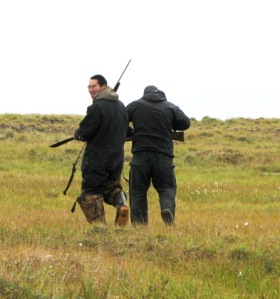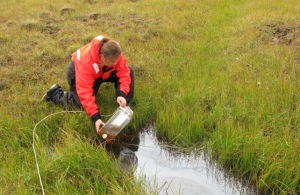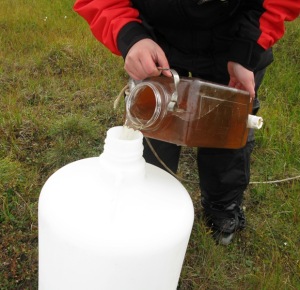Dr. Marc Frischer continues his log of his research trip to Barrow, Alaska. Here is some background information on the research project.
Hi All,
This morning we woke up to reasonable weather, but not the beautiful calm and sunny day that was forecast. It was still foggy and the wind was blowing, but not too bad. The temperature was in the mid 30’s (F), but it felt much colder due to the wind. Captain Quuniq thought that we’d better head straight for the Mead river if we were going to have a chance today of getting those humic samples we’ve been searching for and, if the weather holds, complete our third and last sampling for this trip at our standard station off of Barrow. So we headed back to the Niksiuraq boat ramp and headed southeast to the Mead River. Along with Captain Quuniq was his cousin Nelson who had just returned from a trip on the Mead River. Quuniq brought him along to help out on the boat and help navigate the shallow river waters. Of course they had another agenda as well, but more of that later.
The trip took about two hours mostly hugging the coast to stay out of the wind and waves as much as possible. As we entered the Bay where the Mead River empties into the Beaufort Sea, we slowed down to avoid shallow hazards and to examine the water periodically for the brown tea color characteristic of high humic acid concentrations. Humics are the remains of decaying plant materials that, just like tea leaves steeped in water, turn the water brown. From a chemical perspective humics are carbon rich organic material that microbes should digest and re-inject them into the realm of biology. One of the big climate change questions is what is going to happen to all the humic material that will be released as the permafrost melts? In the western Arctic (where Alaska is) there are literally kilometers of this material in the form of ancient peats buried and currently frozen. Their release into coastal waters will likely have profound implications for the food webs here from the microbes all the way up to whales and humans.
But back to the trip. Although we could clearly see the presence of peats in the summer tundra, the water really didn’t have the brown color we were looking for in the bay or river. Probably there was just too much fresh river water diluting the humics. Our strategy was originally to sample at the river mouth where we hoped to find high concentrations of humics in the water, but since this wasn’t the case we decided to get off the boat and examine one of the many pools that form in the tundra.
The first place we landed we were rewarded two-fold. First, not 10 meters from where we beached the boat, we found exactly what we were looking for. Second, up on a small ridge were two beautiful Caribou bulls.
So we all got off the boat, Rachel Sipler and myself carrying our water collection gear and Quuniq and Nelson with rifles and ammunition.
They are both passionate subsistence hunters and even though they were on the job taking care of us geeky scientists, they just couldn’t let an opportunity like this pass them by. I suspect that they knew they would find Caribou here and were just waiting for an excuse to go hunting. Who can blame them? Soon we were happily collecting our tea colored water and they were stalking the Caribou. Fortunately for the caribou, the gods weren’t with them today and they missed all their shots. Rachel and I were pleased though, since if they had been successful we would have had to share the ride back with two huge dead caribou. Not something we really wanted contaminating our science gear and beautiful clean humic rich water.
After we were all through we all returned to the boat and headed back towards Barrow with the hope of completing our second sampling mission. However, once we got out of the river it became apparent that indeed as Quuniq had predicted, the wind and waves had picked-up significantly. The trip home took over three hours and when we tried to reach our standard sampling site, it was immediately clear that it was too rough to get there safely. Hopefully we’ll be able to get out tomorrow since that will be our last chance before needing to pack-up for our departure.
So please wish us luck again,
marc








I don’t agree. Look at
https://mahabis.com/blogs/journal/arctic-light-by-bjorg-elise-tuppen
Friendly, Yasuko